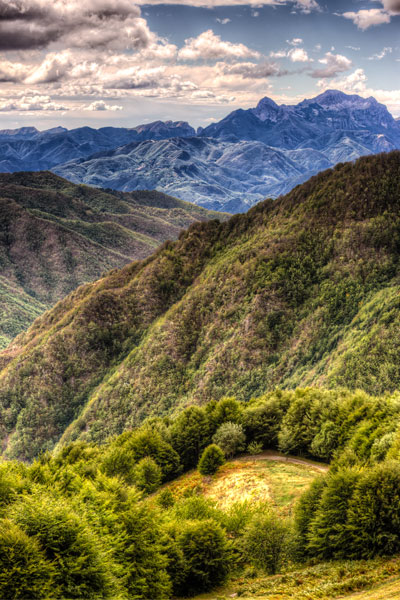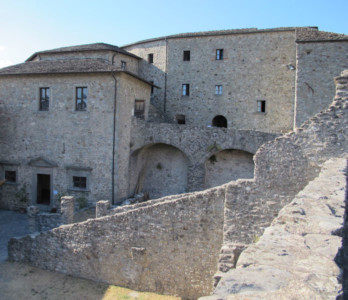29 June 2016
Visit these top seven castles in northern Tuscany for a fairytale-like journey through Lunigiana.
Located between Tuscany and Liguria at the foot of the Emilia Apennines, Lunigiana possesses the loveliest characteristics of all three Italian regions: ancient landscapes, multifaceted cultures, and countless Tuscan castles.
Lunigiana, land of castles

Apuan Alps - © Paul Richards
Lunigiana is a small geographical area, rich in history and full of color, from brilliant green panoramas to the blue of the Apuan Alps. It takes its name from the Roman colony of Luni, founded in 177 BC at the mouth of the Magra River. Its landscapes and towns have always been so abundant in marble that the Normans thought they had reached Rome, but they were only in this part of northern, current-day Tuscany.
Lunigiana is also called the “land of castles,” because every municipality, town, and village had a manor for defense. During the Middle Ages, there were 160 castles in Lunigiana, only thirty of which have survived until present day in a state of good preservation. Many others, like the castle of Agnino di Fivizzano, have fallen into ruin. These ancient buildings are proof of a deeply-rooted history marked by skirmishes among noble families for territorial control.
In 2015, Lunigiana was included in the MAB Reserve of Appennino Tosco-Emiliano, or the Man and Biosphere recognition by UNESCO. This is given to territories whose inhabitants interact with the surrounding environment in harmony, and to preserve its biodiversity and sustainable living habits of its people. The message “Man and Biosphere” is well-suited to the deep connection its centuries of inhabitants have had with the Apennines, from natural and cultural uses to social and political interests.
Since Lunigiana is such a wide territory rich in history, villages, and hiking trails, here is an outline of its profile, drawn from seven of the main castles dotting the valley’s skyline.
Top seven Tuscan castles to see in Lunigiana
1. Aulla Castle
The city of Aulla has many castles, but the best preserved one is surely the Brunella Fortress, a quadrangular construction and a typical example of a fortification built for firearms. Located on the precipice of a rock spur, the fortress takes on a natural defensive form. The Brunella was built in the 16th century, perhaps by Giovanni dalle Bande Nere. The original core is probably dated between the 13th and early 14th centuries, a period in which defense concepts underwent rapid transformations.
2. Piagnaro Castle

Castle of Pontremoli - © Sailko
The castle of Piagnaro, built on the top of the hill dominating the northern part of the town of Pontremoli, is a system of walls and towers erected in defense of the city. Its name comes from the hill on which it was erected, called the Piagnaro because of the prevalence of the piagne stone, often used for roofs in the area. The original fortress was probably built between the 9th and 10th centuries. However, over the centuries it was destroyed and reconstructed many times, to the point where it’s believed that its modern structure dates back mostly to the 14th century. Today, the most ancient part is its semicircular northern tower. Because of numerous rearrangements and reinforcements, the castle seems a fortress. Since 1975, the castle has been the home of the Archaeological Museum, where the Statue Stele, or Standing Stones of Lunigiana are kept. These monoliths feature rather the imposing stone faces of Lunigiana idols: armed warriors and big-bosomed women, created thousands of years ago during the Neolithic and Iron Age in order to protect the villages and all the valley.
3. Malgrate Castle of Villafranca

Castle of Malgrate - © Creative Commons
The main castle of the city (because all these small villages and towns have more than one castle, some better preserved than others) is the Malgrate, located in Villafranca. Originally, it was built purely for defensive purposes, taking full advantage of its position dominating the valley of the Bagnone River. Its characteristically round tower had an unobstructed view of the roads coming from the Cisa Pass, the Apennines and the Garfagnana. Villafranca has also an old mill and small museum, where visitors can learn more about the old farming communities.
4. Malaspina Castle of Fosdinovo
The Malaspina Castle of Fosdinovo is solid and majestic, dominating the entire landscape from the Apuan Alps, the Lunigiana, to the sea. Built in 1124, currently it’s privately owned, but it is open to the public. Admire its excellent conditions and beautiful rooms, such as the "room of Dante," where the famous poet once stayed, or the courtyards and the room of torture. Oh, and be careful, because legend has it that a ghost still lives in the castle: that of young Bianca Maria Aloisia Malaspina. Bianca Maria fell in love with a peasant when she was fifteen. After escaping from the convent of Santa Croce del Corvo and refusing to marry another man, her amore’s parents killed both Bianca Maria and the boy. She was walled alive with her dog (a symbol of fidelity towards the boy she loved) and a wild bear (symbol of rebellion against the will of the parents).
5. Castiglione del Terziere
This castle is not to be missed. It was built in the 13th century, and today Castiglione del Terziere is a small fortification on a hill to the left side of the Magra River. For centuries, Castiglione was fought over by opposing powers in Milan and Florence. The village of Castiglione del Terziere, which developed around the castle over time, is located on high ground at the most eastern part of the Bagnone valley, overlooked by the castle, which shows traces of various phases of the Dark Ages, as well as structures that date back to the 15th century.
6. Castle of Gragnola
In Italian it’s called the Castello dell’Aquila, which means “Castle of the Eagle.” It is located on a hill overlooking the medieval village of Gragnola and the entire eastern Lunigiana territory with a beautiful view of the Apuan Alps. It was likely built by the noble family Bianchi of Erberia between the 9th and 10th centuries. The castle has been recently renovated and reopened to the public, after the decline of the Malaspina family and the devastating earthquake of 1920.
7. Castle of Montignoso
Despite the fact that Montignoso is one of the smallest villages in Lunigiana, the Aghinolfi castle’s strategic position has always allowed it to play an important role in history. It is located on top of a hill from which it overlooks the valley and Tyrrhenian coast below. In 2001, after long restoration works carried out by the Municipality of Montignoso, the castle was finally returned to the local community and to visitors. Inside, a glass floor shows the stratigraphy of the original flooring and ancient artifacts found there. Finally, in 2008, the last restoration work was finished, making it possible to access the archaeological park built inside the outer walls of the castle.
